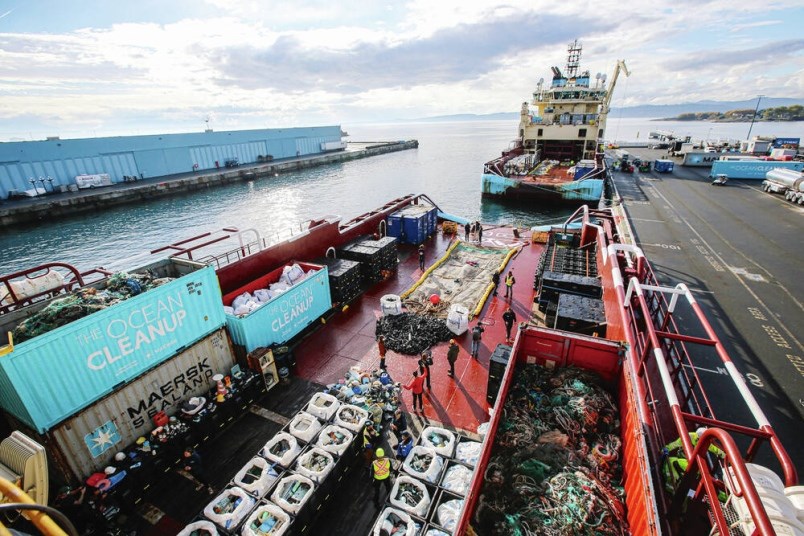A prototype system to collect floating plastic in the Great Pacific Garbage Patch has proven its worth by hauling in 29,000 kilograms of plastic material, the environmental organization behind the effort said Wednesday, as vessels returned to Ogden Point from two back-to-back six-week expeditions.
The team from The Ocean Cleanup, based in the Netherlands, plans to return to the Garbage Patch, 2,000 kilometres offshore, today to gather more plastics using new technology dubbed the “Jenny” system.
“We are going to shift from a testing mindset to a harvesting operation now,” said Boyan Slat, founder and chief executive of the non-profit group, who called the “proof of technology” a milestone. “It’s a great day for the ocean,” Slat said. “It marks the beginning of the end for the Great Pacific Garbage Patch.”
Plastics in the oceans are persistent and do not break down easily. What has been collected so far — fishing gear, toilet seats and crates, among other items — would have remained in the water for another 100 years, he said.
The past decade has seen other prototypes tested as the organization, established in 2013, attempted to develop a functioning model to efficiently collect plastics and to bring in enough support to keep the project alive, he said.
The successful design, the Jenny system, is 800 metres long, with a three-metre-deep skirt underwater to collect plastic under the surface.
Slat describes the experience of waking up two weeks ago to see photos from the Garbage Patch showing 9,000 kilograms of plastics collected in one run as the “best morning of my life.”
“I still get goosebumps” thinking about that moment, he said.
Slat said that often when people think about big environment problems, they seem insurmountable, but the cleanup project shows “we can solve the big problems that we’re facing today.”
Next on the agenda is scaling up the size of the collection system so larger amounts of plastics can be collected. The goal is to develop a fleet able to clean up the Garbage Patch by 2040, he said.
The group’s ambitions are even bigger than that, however: It aims to clean up 90 per cent of the plastic in the world’s oceans.
The challenge has been to collect garbage efficiently while not harming marine life. The system is towed slowly, allowing fish and other marine species to get out of the way. It has hatches permitting fish to escape.
When the plastics come on board, they are sorted and will be packed and shipped to Europe for recycling.
Henk Van Dalen, a director for the organization, said the expedition will be facing more adverse weather as winter approaches, but he sees it as a good learning experience. Plans call for continued operations in 2022. “The ambition is to keep system two out there as long as possible.”
Slat said the Jenny collection project is only one strategy in addressing plastics in the environment, and a mix of solutions will be needed.
The Ocean Cleanup is also focusing on rivers, because most plastics enter oceans through rivers, he said. It has already installed plastic interceptor systems on several rivers and is planning more next year.
The project is operating out of Ogden Point for now and a long-term base for the operation has not been determined.



